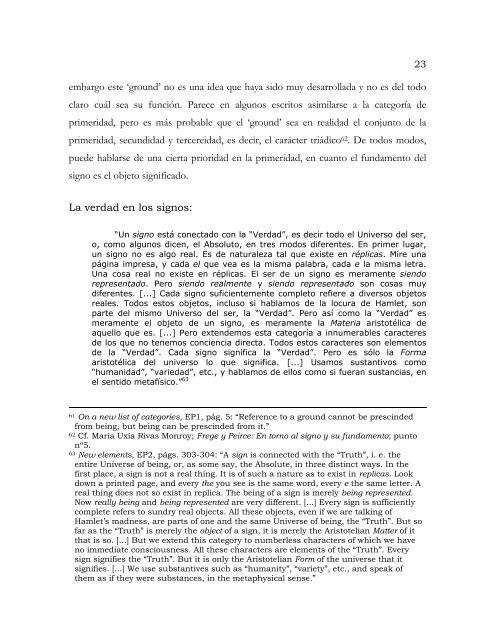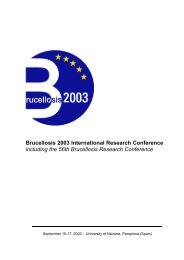Aportes filosóficos de Charles Sanders Peirce - Universidad de ...
Aportes filosóficos de Charles Sanders Peirce - Universidad de ...
Aportes filosóficos de Charles Sanders Peirce - Universidad de ...
Create successful ePaper yourself
Turn your PDF publications into a flip-book with our unique Google optimized e-Paper software.
23<br />
embargo este ‘ground’ no es una i<strong>de</strong>a que haya sido muy <strong>de</strong>sarrollada y no es <strong>de</strong>l todo<br />
claro cuál sea su función. Parece en algunos escritos asimilarse a la categoría <strong>de</strong><br />
primeridad, pero es más probable que el ‘ground’ sea en realidad el conjunto <strong>de</strong> la<br />
primeridad, secundidad y tercereidad, es <strong>de</strong>cir, el carácter triádico 62 . De todos modos,<br />
pue<strong>de</strong> hablarse <strong>de</strong> una cierta prioridad en la primeridad, en cuanto el fundamento <strong>de</strong>l<br />
signo es el objeto significado.<br />
La verdad en los signos:<br />
“Un signo está conectado con la “Verdad”, es <strong>de</strong>cir todo el Universo <strong>de</strong>l ser,<br />
o, como algunos dicen, el Absoluto, en tres modos diferentes. En primer lugar,<br />
un signo no es algo real. Es <strong>de</strong> naturaleza tal que existe en réplicas. Mire una<br />
página impresa, y cada el que vea es la misma palabra, cada e la misma letra.<br />
Una cosa real no existe en réplicas. El ser <strong>de</strong> un signo es meramente siendo<br />
representado. Pero siendo realmente y siendo representado son cosas muy<br />
diferentes. [...] Cada signo suficientemente completo refiere a diversos objetos<br />
reales. Todos estos objetos, incluso si hablamos <strong>de</strong> la locura <strong>de</strong> Hamlet, son<br />
parte <strong>de</strong>l mismo Universo <strong>de</strong>l ser, la “Verdad”. Pero así como la “Verdad” es<br />
meramente el objeto <strong>de</strong> un signo, es meramente la Materia aristotélica <strong>de</strong><br />
aquello que es. [...] Pero exten<strong>de</strong>mos esta categoría a innumerables caracteres<br />
<strong>de</strong> los que no tenemos conciencia directa. Todos estos caracteres son elementos<br />
<strong>de</strong> la “Verdad”. Cada signo significa la “Verdad”. Pero es sólo la Forma<br />
aristotélica <strong>de</strong>l universo lo que significa. [...] Usamos sustantivos como<br />
“humanidad”, “variedad”, etc., y hablamos <strong>de</strong> ellos como si fueran sustancias, en<br />
el sentido metafísico.” 63<br />
61 On a new list of categories, EP1, pág. 5: “Reference to a ground cannot be prescin<strong>de</strong>d<br />
from being, but being can be prescin<strong>de</strong>d from it.”<br />
62 Cf. María Uxía Rivas Monroy; Frege y <strong>Peirce</strong>: En torno al signo y su fundamento; punto<br />
nº5.<br />
63 New elements, EP2, págs. 303-304: “A sign is connected with the “Truth”, i. e. the<br />
entire Universe of being, or, as some say, the Absolute, in three distinct ways. In the<br />
first place, a sign is not a real thing. It is of such a nature as to exist in replicas. Look<br />
down a printed page, and every the you see is the same word, every e the same letter. A<br />
real thing does not so exist in replica. The being of a sign is merely being represented.<br />
Now really being and being represented are very different. [...] Every sign is sufficiently<br />
complete refers to sundry real objects. All these objects, even if we are talking of<br />
Hamlet’s madness, are parts of one and the same Universe of being, the “Truth”. But so<br />
far as the “Truth” is merely the object of a sign, it is merely the Aristotelian Matter of it<br />
that is so. [...] But we extend this category to numberless characters of which we have<br />
no immediate consciousness. All these characters are elements of the “Truth”. Every<br />
sign signifies the “Truth”. But it is only the Aristotelian Form of the universe that it<br />
signifies. [...] We use substantives such as “humanity”, “variety”, etc., and speak of<br />
them as if they were substances, in the metaphysical sense.”
















